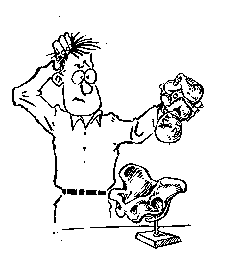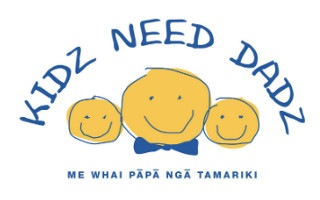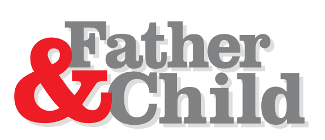Involving Dads in Ante-Natal Classes
By Harald Breiding-Buss
The art and importance of involving fathers in ante-natal classes

The Father & Child Trust offers the material on this page as a 17 page A4 resource for providers of ante-natal education. Contains full instructions for a module on fatherhood and relationship issues, including overheads and handouts. A must for every birthing hospital.
Hard Copies can be ordered for $6 (incl. P&P) and include templates for overheads/handouts.
Email: info@fatherandchild.org.nz
“In ante-natal classes, both first-time mothers and fathers tend to express their ideal that there is no significant difference between the mother’s and the father’s role; that they both engage in a relationship with their child that is nurturing and caring; that they share whatever duties come up. But a year into the life of the baby, things already look different.
A Word From The Author (Introduction)
Times have changed. When our grandparents got married, gender roles were clearly sorted out even before they had children: He would be primarily responsible for earning the income – and stay away from babies and young children. She would be primarily responsible for working in the house – and stay away from paid employment. Much of their childhood was spent preparing them for these roles.
This is no longer so. When men and women choose a partner today, they no longer look for someone to complement a role they are not allowed to fulfill, but for a soul-mate, a companion. Census data shows that in modern couples, the man and the woman have very similar education and income status. If anything, more and more women are looking for a partner that will relieve them from their stereotypical responsibilities around the house, and men hope to find a mate that will share the provider and protector burden with them.
In ante-natal classes, both first-time mothers and fathers tend to express their ideal that there is no significant difference between the mother’s and the father’s role; that they both engage in a relationship with their child that is nurturing and caring; that they share whatever duties come up. But a year into the life of the baby, things already look different. Many women complain that for dad “the novelty has worn off”, and many men say that they are only asked to share the duties, but given no real say in parenting matters.
For both communicating their feelings to their partners has become harder. A few years on and the formerly democratic couple may have developed into the stereotypical family – he the income provider, she the nurturer and caregiver.
What used to be soul-mates are now partners in a venture called “family” with clearly divided responsibilities. More and more often such relationships fall apart, because the common ground that once united them has vanished. How did that happen?
Parents are subjected to an onslaught of information and impressions that softly but firmly squeeze them into stereotypical roles far more than men and women without children. Screen through the books you read to your own toddler or flick through the newspaper of today for parenting articles and see how the words “mother” and “parent” are used interchangeably, how there is an unspoken assumption that all significant parenting is done by the mother, and that babies and children love no-one else more or equally. All support systems for new parents are geared towards the mother, while the father comes under increased pressure to provide his family with economical security.
Children feature a lot in women’s magazines, but are hard to find in men’s. The majority of movies flickering over our screens at home feature fathers as providers and protectors on a mission outside the home (sometimes violent towards their own families), and mothers in a nurturing role with young children (never violent towards them). Your local childcare worker will refer to “mum” about 25 times as often as to “dad” when speaking to your child, subconsciously fostering a bond to only one parent.
The everyday life that used to be increasingly similar before the couple had a child couldn’t be any more different now. Mum may feel trapped in the house, while dad may feel more and more like a visitor. Needs, which have been similar before, are now diametrically opposed. This change causes not only relationship breakups, but probably post-natal depression in both women and men – and related signs such as violence or suicide.
We cannot help people become parents unless we understand the pressure of those subtle messages and the huge change we require men and women to make in diverging directions. We cannot prevent relationship breakups unless we realise how we ourselves, as professionals, in our language and attitudes consciously or subconsciously foster and encourage one particular family model, because we assume (wrongly) that this is the “norm”. Our grandparents didn’t break up, because a new baby only added to their respective burdens, but it didn’t require the complete role transformation that we require of a modern couple.
But here is the good news: like no other parent education courses, ante-natal classes are attended by both women and men. Those who run ante-natal classes have a unique opportunity at hand to help a couple identifying their own needs among the debris of social expectations and to foster true partnerships. At no other point in the new parents’ future lives will this be so “easy” again. Along with this comes a responsibility of providers to listen to what parents want and need, and encourage and foster the arrangements they want.
By doing this we won’t eliminate the stereotypical family, because this model suits a lot of families, as does the “reversed” stereotypical family. But there are lots of arrangements in between that parents may want to try, and they deserve the right to do so. New parents are insecure, anxious to do everything right. They are asking you for help, if not with words, then with their eyes and body language.
The cues they get from professionals at this stage are very powerful. Because men and women have more choices today, ante-natal classes must not take these choices away from the couple, or favour one choice over another. Involving fathers in ante-natal classes means being prepared to listen to their needs, too, and keeping up with the times.




